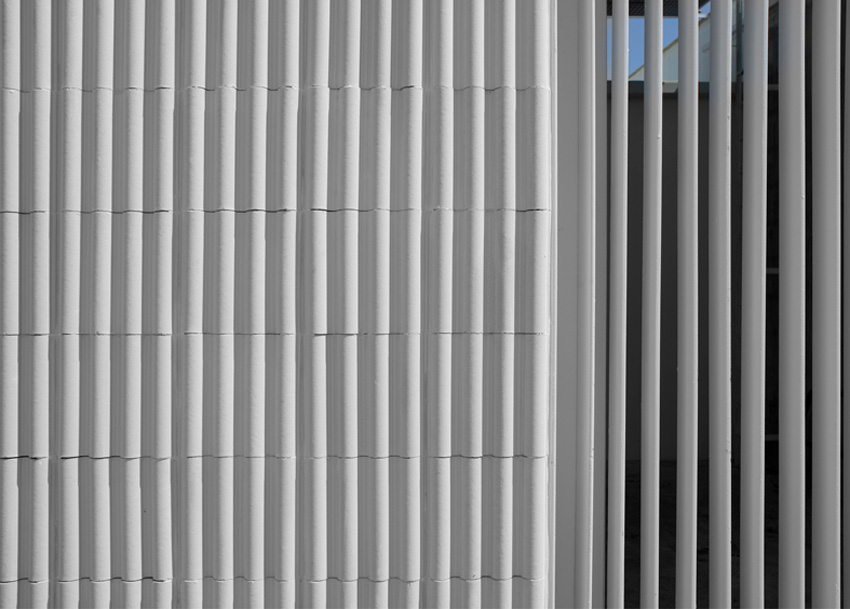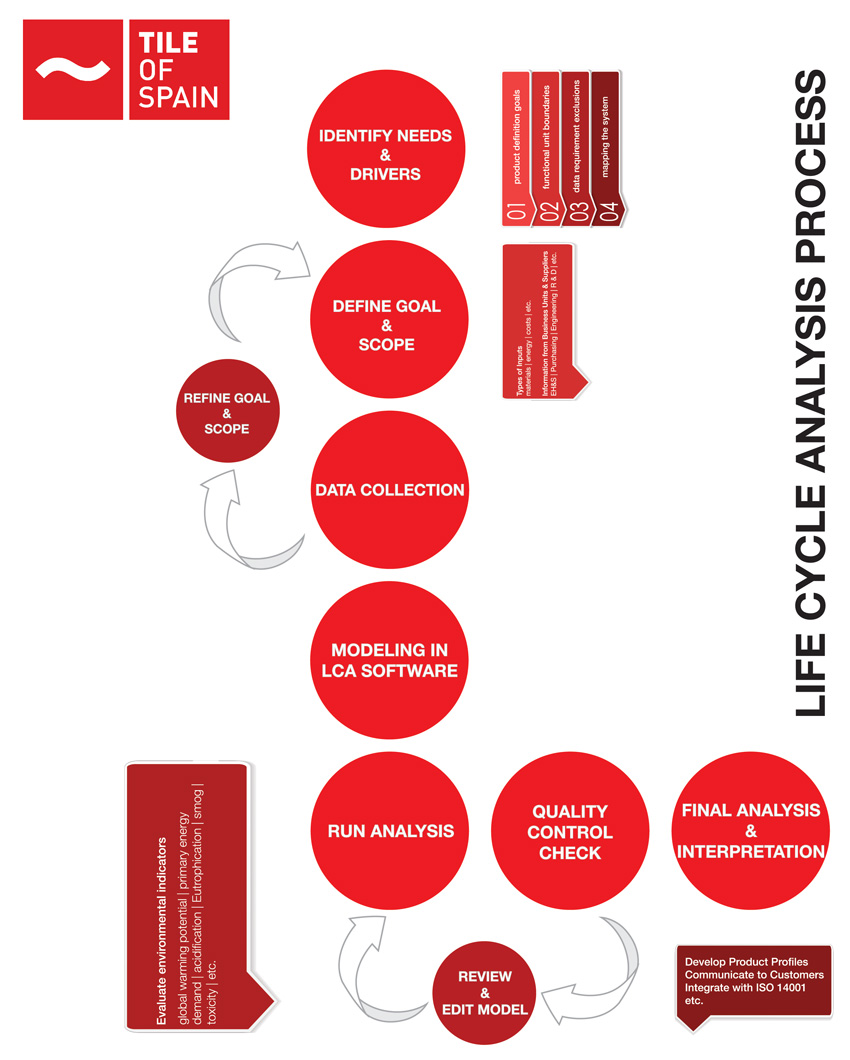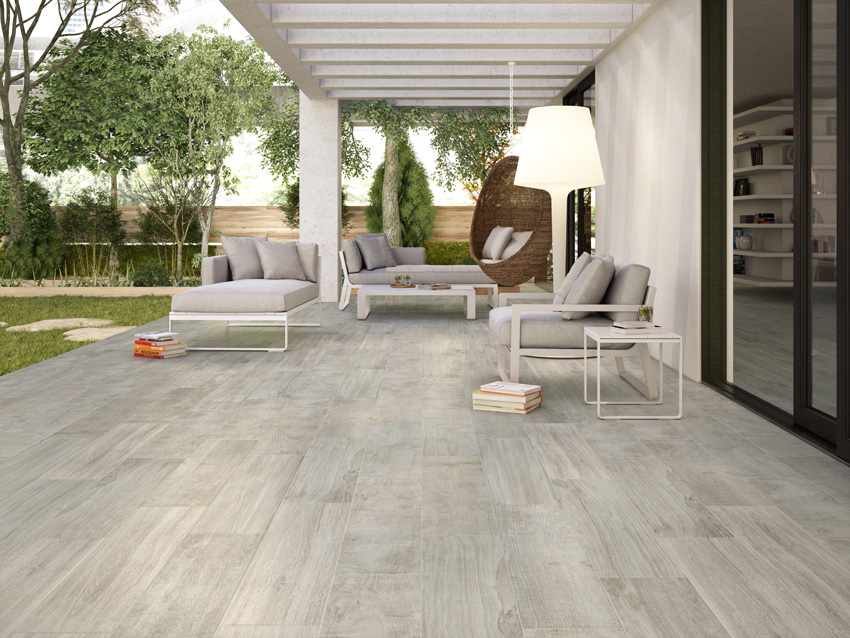Innovation and Industry: Ceramic’s Sustainable Story
A Life-Cycle Initiative
In Europe, and particularly in Spain, from ancient Alhambra to today’s architects who are using ceramics in Passive Haus and LEED projects, ceramic tile has been a prime building material known for its durability and aesthetics. As a response to 21st century environmental initiatives, a new study titled “Sectoral Life-Cycle Analysis of Ceramic Tiles” was initiated in order to offer real and transparent information about the manufacturing, production, and material content of ceramic tiles and their impact on the environment. This analysis developed new sustainability goals for the ceramic industry.
More than 50 Spanish companies from the ceramic tile sector (manufacturers of finished products, spray-dried powder, glazes, etc.) took part in the research program accounting for about 40 percent of that region’s tile production. LCA requires the collection of quantifiable materials that can be evaluated through a lens of environmental flows from input of raw materials to the output of a finished product. The study included red or white body earthenware wall tiles, glazed white or red body stoneware tiles, and porcelain tiles.
Researchers analyzed the entire life cycle of tile from the extraction of raw materials, transportation, manufacture, and distribution to the point of use and waste management.
The study was designed:
- “to obtain scientifically valid and objective reference values for the environmental loads of ceramic tiles by performing an LCA; and
- to draw up product category rules (PCRs) that are applicable to ceramic tiles so that they can be used in the preparation of environmental product declarations (EPDs).”4
As Ryan Fasan, technical consultant for Tile of Spain, states, “One of the essential actions to improve a product’s sustainability is to study its global environmental profile throughout its entire life cycle. It is possible to describe a product as ‘green’ when its life cycle evidences its efficient consumption of raw materials, causes only a limited impact on the environment, is functionally suitable for use, is not harmful during its usage phase, and does not generate any negative impacts on the environment during its disposal or recovery at the end of its working life.” This public-private initiative generated a movement toward a deeper commitment to sustainability and demonstrates how a public-private initiative from the government, university, business, and manufacturers can make a substantial change toward the protection of individuals and the environment.

Photo courtesy of Tile of Spain
Shown is a closeup of a ceramic exterior panel from the Spanish “lattice house” designed by Emiliano López & Mónica Rivara Architects.

Image courtesy of Tile of Spain
LCA development process
The Environmental Footprint of Ceramic Tiles
According to the LCA study, the greatest environmental impact for all categories is in the manufacture and distribution of ceramic tile. Tile is composed primarily of natural clay, feldspars, sand, carbonites, and kaolins. These raw materials are transported to the manufacturing plants, causing transportation expenses and environmental degradation. Industry clusters like Castellón in Spain help to mitigate this environmental burden through close proximity to abundant supply of these materials, close proximity to port for efficient transport of any imported goods, and proximity to neighboring companies to share trucking to a centralized and accessible area. Costly electrical and thermal energy is used in the spray drying and firing phases. Heat siphoning and cogeneration practices are employed to mitigate the necessary burdens of these processes. Water discharges and material waste were not considered in the inventory because the tile industry already directly recycles water and waste back as standard industry practice. However, water and material waste are inventoried as an area for improvement as the material is classified and packaged.
Once purchased, the impact of the types of mortar chosen and cleaning applications depended on the final user and on the type of use. Ceramic tile is durable, and the average useful life of this material is estimated as 50 years, according to UNE-EN 14411: 2007 Ceramic tiles: Definitions, Classifications, Characteristics, and Marking (UNE is the Spanish Association for Standardization). Tiles represent 0.32 percent of the total weight of a building. The study set the benchmark of the impact of ceramic tiles if deposited as inert building materials in landfills.
The LCA determined that the primary environmental impact of this industry is in the manufacturing phase. Based on this data, different manufacturers are benchmarking their environmental footprint and making changes to achieve the European Union’s stringent multi-attribute ecolabel. A few highlights of these initiatives include reductions in emissions, innovative water use and reuse, and reductions in waste.
Reduction in Emissions and Water Use
Ceramic manufacturers are reducing their emissions to save energy. In the past 20 years, the industry has tripled its production yet managed to reduce gaseous emissions by 75 percent of the original 1970s consumption levels.
Some tile manufacturers are using cogeneration as a new heat source. Co-generation, or combined heat and power(CHP), is the generation of heat and electricity simultaneously to maximize energy usage. CHP is considered to be one solution to Kyoto targets, as it highly reduces emissions of CO2 to the environment. Cogeneration can provide energy savings ranging between 15–40 percent when compared to the supply of electricity and heat from conventional power stations and boilers. In addition to using CHP systems to provide heat, these manufacturers sell their excess electrical energy to local electricity companies. Along with energy, equipment, and lighting audits, tile manufacturers are reducing their greenhouse emissions and saving energy.
The FERTILIFE project focuses on the reduction of greenhouse gas emissions by the ceramic tile factories in the area of Castellón de la Plana, Spain, using the CO2 captured in agriculture.5 In this way, it promotes the use of agriculture as a natural CO2 sink by recovering this waste gas to make irrigation water more acidic. This project is cofinanced by the European Union within the LIFE Climate Change Mitigation Programme. This program made it possible for tile manufacturers in Spain to use wastewater from the manufacturing plant to irrigate orange groves. This brings industry in the region full circle. Originally, the major industry was orange farming. Many of the groves were removed by the farmers to make spaces for ceramic plants. These same orange farmers became the founding owners of modern ceramic industry. Now those ceramic facilities are creating a way to revitalize the iconic orange groves of the region.
Reduction in Waste
The raw materials of ceramic tile are abundant natural resources. Manufacturers eliminate material waste by recycling scraps as they are cut. Similar to piecrusts, the excess trimmings are sent back to the beginning of the process to be reground and reformed into fresh material.
LIFECERAM is a project funded by numerous organizations that made it possible to manufacture a ceramic product for urban paving with a base and a coating obtained from ceramic waste generated within the process itself.6 This project examined waste that could not be easily recycled within the manufacturing process. These products included fired and unfired biscuits (tile before a glaze is applied), sludge from glazing and polishing lines, and dust from the kiln bag filters. Through the redesign of a highly sustainable manufacturing process, new manufacturing processes have been identified as well as new products developed for increasing markets.
Several manufacturers are incorporating recycled materials making even more reductions in the use of a natural resource. Some products are made with up to 80 percent preconsumer recycled material. The innovative LIFE Foundrytile project is an initiative that led to the use of the waste of fine fraction and sands of iron smelting to be repurposed in the production of ceramic tiles. This initiative takes advantage of the disposable production waste of one industry and uses it as raw material in another.
This cradle-to-cradle initiative is designed to produce savings in both industries while reducing the environmental impact of landfilled waste. It has been estimated that in Spain, the production of ceramic tiles could absorb all the byproducts generated in iron smelting. If replicated in Europe, the ceramic industry would be able to absorb 75 percent of foundry waste.7 The LIFE program is the European Union’s funding instrument for the environment and climate action. The general objective of LIFE is to contribute to the implementation, updating, and development of EU environmental and climate policy and legislation by cofinancing projects with European added value.8

Photo courtesy of Tile of Spain
High-quality ceramic tiles meet LEED V4 criteria and can be specified with LCA certifications.









